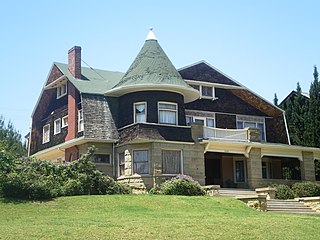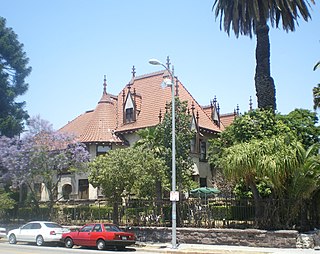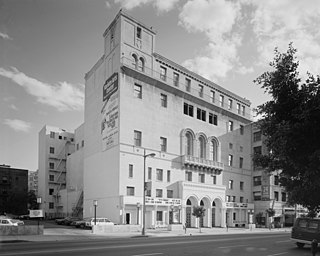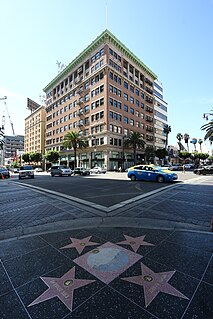
The California Club is a by-invitation members-only private club established in 1888 which is the second-oldest such club in Southern California. The club's clubhouse was listed on the National Register of Historic Places in 2010.

Center for the Arts Eagle Rock, formerly known as the Eagle Rock Branch Library and the Eagle Rock Community Cultural Center, is a historic Mission Revival and Spanish Colonial Revival style building in Eagle Rock, in north-central Los Angeles County, California.

Second Church of Christ, Scientist is a historic former Christian Science church building located at 948 West Adams Boulevard, in the West Adams district of Los Angeles, California. It is now the Art of Living Center Los Angeles.

The Ebell of Los Angeles is a women's club housed in a complex in the Mid-Wilshire section of Los Angeles, California. It includes a clubhouse building and the 1,270-seat Wilshire Ebell Theatre.

Alvarado Terrace Historical District is a designated historic district in the Pico-Union district of Los Angeles, California. It is located southwest of Downtown Los Angeles, along Alvarado Terrace between Pico Boulevard and Alvarado Street.

Granada Shoppes and Studios, also known as the Granada Buildings, is an imaginative, Mediterranean Revival and Spanish Colonial Revival style block-long complex consisting of four courtyard-connected structures, in Central Los Angeles, California. It was built immediately to the southeast of Lafayette Park in the Westlake District, in 1927.

Susana Machado Bernard House and Barn is an elaborate 10,000-square-foot (930 m2) Art Nouveau Gothic Revival style mansion and carriage house located in the Pico Union section of Los Angeles, California. Built in 1901, the house was designed by architect John B. Parkinson (1861–1935). Parkinson also designed the Los Angeles Memorial Coliseum, Union Station and Los Angeles City Hall. Noted for its Gothic style with soaring spaces, the house has vaulted ceilings and curved walls. In 1979, it was designated a Los Angeles Historic-Cultural Monument, and listed on the National Register of Historic Places. The property was purchased in 1996 by the Center for Human Rights & Constitutional Law. Since 2002, the house has been operated as the Casa Libre/Freedom House, a fourteen-bed shelter for homeless minors. In May 2003, the Los Angeles Times profiled the shelter, noting the following: "Casa Libre/Freedom House occupies a newly renovated mansion near MacArthur Park. Registered as a state, county and federal historic site, the home's gothic facade rises elegantly from the corner of South Lake Street and James M. Wood Boulevard. The shelter arranges for schooling, counseling, and medical care for undocumented and unaccompanied immigrant children, mainly from Latin America.

Mary Andrews Clark Memorial Home is a four-story, 76,000-square-foot (7,100 m2) "French Revival Chateauesque" brick structure in the Westlake neighborhood of Los Angeles near downtown. It was built in 1913 as a YWCA home for young working women.

The Friday Morning Club building is located in Downtown Los Angeles, California. It was the second home of the women's club also named the Friday Morning Club (FMC), for 61 years.

Young's Market Company Building built in 1924 is a historic building located at 1610 West 7th Street, corner South Union Avenue, in the Westlake neighborhood of Los Angeles, California.

Los Angeles Historic-Cultural Monuments are sites which have been designated by the Los Angeles, California, Cultural Heritage Commission as worthy of preservation based on architectural, historic and cultural criteria.

The 28th Street YMCA is a historic YMCA building in South Los Angeles, California. It was listed as a Los Angeles Historic-Cultural Monument in 2006 and put on the National Register of Historic Places in 2009. The four-story structure was built in 1926 at a cost of $200,000. The building was designed by noted African American architect Paul R. Williams in the Spanish Colonial Revival style.

Angelus Funeral Home is a funeral home in South Los Angeles, California. It was listed as a Los Angeles Historic-Cultural Monument in 2006 and on the National Register of Historic Places in 2009. In 1925, Angelus Funeral Home was the first Black-owned business to be incorporated in California. The current building on Crenshaw Boulevard was designed by noted African-American architect Paul R. Williams in the Spanish Colonial and Georgian Revival styles and also includes Art Deco elements.

The Broadway Hollywood Building is a building in Los Angeles' Hollywood district. The building is situated in the Hollywood Walk of Fame monument area on the southwest corner of the intersection referred to as Hollywood and Vine, marking the intersection of Hollywood Boulevard and Vine Street. It was originally built as the B. H. Dyas Building in 1927. The Broadway Hollywood Building is referred to by both its main address of 6300 Hollywood Boulevard and its side address of 1645 Vine Street.

















